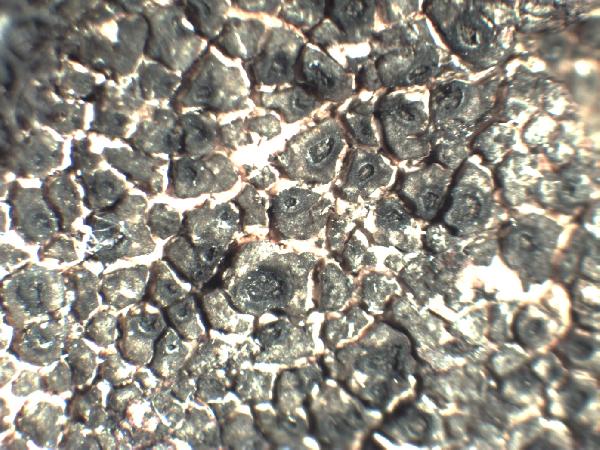Aspicilia fluviatilis A. Nordin & Owe-Larss.
Lichenologist, 43: 30, 2011.
Synonyms: Aspicilia cinerea f. alpina Arnold ?
Description: Thallus crustose-placodioid, episubstratic, cream-coloured, pale grey or ochraceous grey, partly with a brownish tinge, 0.2-0.5 mm thick, the inner part irregularly cracked-areolate, in outer part forming a dendroid branching pattern, the areoles smooth, flat to slightly convex, angular and 0.2-0.4 mm wide in central parts, elongated, radiating, branched and 0.5-1 mm long in marginal parts. Cortex paraplectenchymatous, obscured by norstictic acid crystals, c. 22-43 μm. thick, the cells c. 5-9 μm wide; epinecral layer up to 8 μm thick; medulla white, with abundant Ca-oxalate crystals; hypothallus absent or dark brown to black, visible between the areoles in the inner part of the thallus, sometimes also in the marginal zone. Apothecia lecanorine-aspicilioid, immersed to broadly attached, round to irregular, sometimes confluent, 0.2-0.7 mm across, 1-2(-4) per areole, with a dark brown to black, at first smooth but soon uneven, concave to slightly convex, sometimes grey-white pruinose (norstictic acid) disc, the thalline margin blackening in older apothecia, usually with a white inner rim. Proper exciple c. 40-55 μm thick in upper part, narrowing below; epithecium brown-green (Caesiocinerea-green), N+ green, K+ red-brown; hymenium colourless, 50-100 μm high; paraphyses branched and anastomosing, the apical cells mainly moniliform, subglobose, up to 3.5 μm wide; hypothecium colourless, 40-90 μm high. Asci 8-spored, clavate, the thin outer coat K/I+ blue, the wall and apical dome K/I-. Ascospores 1-celled, hyaline, broadly ellipsoid, 15-25(-28) x (5-)7-13(-16) μm. Pycnidia rare, the wall pigmented in upper part only. Conidia thread-like, 11-17 x c. 1 μm. Photobiont chlorococcoid. Spot tests: thallus and sometimes apothecial disc (pruina) K+ yellow turning red (needle-like crystals), C-, KC-, P+ yellow orange. Chemistry: norstictic acid in cortex and in the pruina of the apothecia; Caesiocinerea-green pigment in the epithecium.
Growth form: Crustose placodiomorph
Substrata: rocks
Photobiont: green algae other than Trentepohlia
Reproductive strategy: mainly sexual
Commonnes-rarity: (info)
Alpine belt: extremely rare
Subalpine belt: absent
Montane belt: absent
Dry submediterranean belt: absent
Humid submediterranean belt: absent
Padanian area: absent
pH of the substrata:
1 2 3 4 5
Solar irradiation:
1 2 3 4 5
Aridity:
1 2 3 4 5
Eutrophication:
1 2 3 4 5
Poleotolerance:
0 1 2 3
Altitudinal distribution:
1 2 3 4 5 6
Rarity
absent
extremely rare
very rare
rare
rather rare
rather common
common
very common
extremely common
Loading data...
Occurrence data
Predictive map
Growth form: Crustose placodiomorph
Substrata: rocks
Photobiont: green algae other than Trentepohlia
Reproductive strategy: mainly sexual
Commonnes-rarity: (info)
Alpine belt: extremely rare
Subalpine belt: absent
Montane belt: absent
Dry submediterranean belt: absent
Humid submediterranean belt: absent
Padanian area: absent
pH of the substrata:
| 1 | 2 | 3 | 4 | 5 |
Solar irradiation:
| 1 | 2 | 3 | 4 | 5 |
Aridity:
| 1 | 2 | 3 | 4 | 5 |
Eutrophication:
| 1 | 2 | 3 | 4 | 5 |
Poleotolerance:
| 0 | 1 | 2 | 3 |
Altitudinal distribution:
| 1 | 2 | 3 | 4 | 5 | 6 |
Rarity
absent
extremely rare
very rare
rare
rather rare
rather common
common
very common
extremely common
Loading data...
Occurrence data
Predictive map







